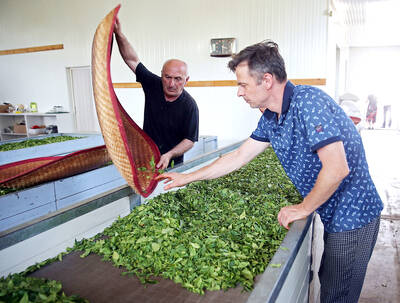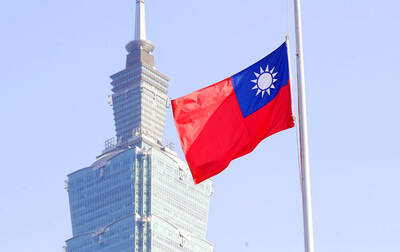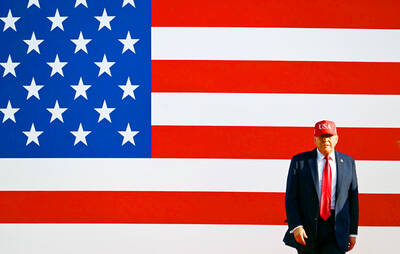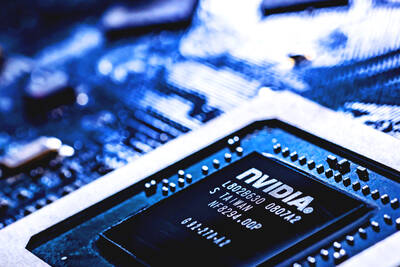Bank of Japan (BOJ) board members said they need to counter the mistaken perception that central bank asset purchases will automatically increase, the minutes of a meeting last month show.
“Members made note of some misunderstanding that the bank would continue to increase the size of its program in an automatic manner,” until the BOJ’s 1 percent price goal is met, according to the record of an April 27 meeting released yesterday in Tokyo. “They agreed that the bank needed to fully explain that it made decisions on its monetary policy stance after carefully assessing the economic and price situation.”
The yen’s 5 percent climb against the US dollar since mid-March is weighing on the profits of Japanese exporters, suggesting that lawmakers and manufacturers will continue to press for more stimulus. The BOJ needs to avoid being seen financing government deficit spending and has highlighted limits to what monetary policy alone can achieve in fueling growth and ending deflation.
“The BOJ is emphasizing they will act according to the price outlook, which will be affected by developments in currencies,” Tokyo-based Shinkin Asset Management chief economist Hiroshi Miyazaki said. “Whether it wants to or not, the BOJ won’t have a choice but to increase asset purchases if the yen strengthens significantly.”
The yen traded at 79.35 per US dollar as of 2:42pm in Tokyo yesterday. The central bank has increased its asset-purchase fund twice this year, with the first move in February helping to weaken the yen against the US dollar. Renewed concerns over Europe’s are now lending support to the currency.
BOJ Governor Masaaki Shirakawa and his board added ¥10 trillion (US$126 billion) to the purchase program last month.
The government faces the challenge of extending an economic recovery after last year’s earthquake and tsunami without worsening the finances of a nation already bearing the world’s biggest public debt burden.
Fitch Ratings last week cut Japan’s sovereign-debt rating, saying the government’s plans for fiscal consolidation look “leisurely.”
A few BOJ members said last month that it was important the central bank makes it clear that its bond purchases are not meant to finance government debt, the minutes showed.
BOJ staff members at the gathering said increasing holdings of exchange-traded funds, which are bought through the facility, entail “a considerable risk of price volatility,” according to the minutes.
The board refrained from extra easing at a meeting last week, while Shirakawa pledged to continue “powerful monetary easing.”
The central bank forecasts price growth of 0.7 percent in the year starting April next year.
The yield on Japan’s benchmark 10-year debt fell one basis point to 0.875 percent.

When Lika Megreladze was a child, life in her native western Georgian region of Guria revolved around tea. Her mother worked for decades as a scientist at the Soviet Union’s Institute of Tea and Subtropical Crops in the village of Anaseuli, Georgia, perfecting cultivation methods for a Georgian tea industry that supplied the bulk of the vast communist state’s brews. “When I was a child, this was only my mum’s workplace. Only later I realized that it was something big,” she said. Now, the institute lies abandoned. Yellowed papers are strewn around its decaying corridors, and a statue of Soviet founder Vladimir Lenin

ELECTRONICS BOOST: A predicted surge in exports would likely be driven by ICT products, exports of which have soared 84.7 percent from a year earlier, DBS said DBS Bank Ltd (星展銀行) yesterday raised its GDP growth forecast for Taiwan this year to 4 percent from 3 percent, citing robust demand for artificial intelligence (AI)-related exports and accelerated shipment activity, which are expected to offset potential headwinds from US tariffs. “Our GDP growth forecast for 2025 is revised up to 4 percent from 3 percent to reflect front-loaded exports and strong AI demand,” Singapore-based DBS senior economist Ma Tieying (馬鐵英) said in an online briefing. Taiwan’s second-quarter performance beat expectations, with GDP growth likely surpassing 5 percent, driven by a 34.1 percent year-on-year increase in exports, Ma said, citing government

UNIFYING OPPOSITION: Numerous companies have registered complaints over the potential levies, bringing together rival automakers in voicing their reservations US President Donald Trump is readying plans for industry-specific tariffs to kick in alongside his country-by-country duties in two weeks, ramping up his push to reshape the US’ standing in the global trading system by penalizing purchases from abroad. Administration officials could release details of Trump’s planned 50 percent duty on copper in the days before they are set to take effect on Friday next week, a person familiar with the matter said. That is the same date Trump’s “reciprocal” levies on products from more than 100 nations are slated to begin. Trump on Tuesday said that he is likely to impose tariffs

HELPING HAND: Approving the sale of H20s could give China the edge it needs to capture market share and become the global standard, a US representative said The US President Donald Trump administration’s decision allowing Nvidia Corp to resume shipments of its H20 artificial intelligence (AI) chips to China risks bolstering Beijing’s military capabilities and expanding its capacity to compete with the US, the head of the US House Select Committee on Strategic Competition Between the United States and the Chinese Communist Party said. “The H20, which is a cost-effective and powerful AI inference chip, far surpasses China’s indigenous capability and would therefore provide a substantial increase to China’s AI development,” committee chairman John Moolenaar, a Michigan Republican, said on Friday in a letter to US Secretary of